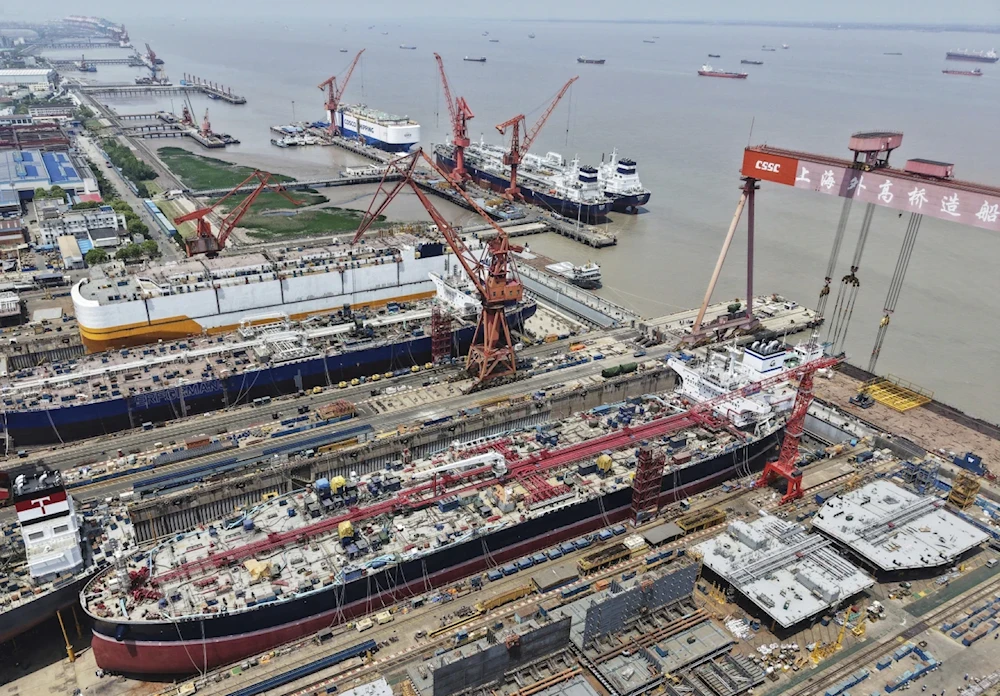China trade flows defy Trump's heavy US tariffs, surge 7% in April
China’s strong sea and air cargo volumes suggest resilient export activity despite rising US tariffs.
-

A view of ships under construction at the Shanghai shipyard in Shanghai, China, April 20, 2025 (Chinatopix via AP)
China’s trade flows expanded steadily at the end of April, signaling that rising US tariffs have not yet disrupted actual shipment volumes, even as economists warn of long-term risks to growth.
According to data released Tuesday by the Chinese Ministry of Transport, Chinese ports processed 6.7 million containers in the week ending April 27, marking a 7% increase from the same period last year.
A Bloomberg analysis of the data shows that this growth trend held steady throughout the previous four weeks, suggesting that April exports remained solid despite geopolitical headwinds.
Resilient performance, unexpected strength
Given that sea cargo makes up the majority of China’s international trade, the steady rise in container volumes points to a likely resilient performance in official April export figures, which are due to be released on Friday. Analysts believe that Chinese companies may have redirected shipments toward Southeast Asia and other regions where US tariffs remain suspended.
Air cargo also demonstrated unexpected strength. The number of international cargo flights rose 30% in the four weeks ending April 27, compared to the same period last year.
Temu, Shein drive air cargo spike
The surge was likely fueled by booming e-commerce demand, particularly from platforms like Temu and Shein. Both companies reportedly ramped up shipments before the expected closure of the “de minimis” tariff loophole on May 2, which had allowed small-value shipments to enter the US duty-free.
The "de minimis" tariff loophole previously allowed goods valued under $800 to enter the US without tariffs or extensive customs checks for shipments from China and Hong Kong. Originally intended to simplify low-value imports, the rule was heavily exploited by Chinese e-commerce giants like Temu and Shein to ship millions of parcels duty-free, bypassing tariffs imposed on bulk imports. This gave the brands a competitive edge.
As of May 2025, the US has not only revoked this exemption for Chinese-origin goods but also imposed new tariffs, aiming to curb unfair trade practices, close regulatory gaps, and address concerns over labor and environmental standards.
US-bound shipments decline amid rising tariffs
Despite overall trade resilience, the volume of China-US trade appears to be slipping. The number of cargo ships departing Chinese ports for the United States dropped to around 47 in late April, down sharply from a peak of 73 earlier in the month, according to ship tracking data compiled by Bloomberg.
Economists warn that newly imposed US tariffs, some as high as 145%, are expected to weigh on export momentum later in the year. While exemptions may cushion some sectors, the long-term impact on global demand could become more visible in the second half of 2025.
Mattel Inc. had announced in March plans to raise prices on certain toys in the US to counteract increased costs from Trump’s 145% tariffs on Chinese-made goods. Despite efforts to shift manufacturing away from China, which currently constitutes 40% of its global production, the company acknowledges that some price hikes are unavoidable, according to the Associated Press (AP).
Official export data expected to show modest growth
Economists polled by Bloomberg forecast exports will grow 2.5% from a year ago. While this marks a slowdown from the 12% jump recorded in March, it is still considered a solid performance given the tariff backdrop.
According to official figures, net exports contributed to 40% of China’s economic growth in the first quarter of 2025, up from 30% for the full year 2024. The Ministry of Transport released the latest cargo data after a brief reporting delay, just ahead of the broader trade report.

 4 Min Read
4 Min Read








